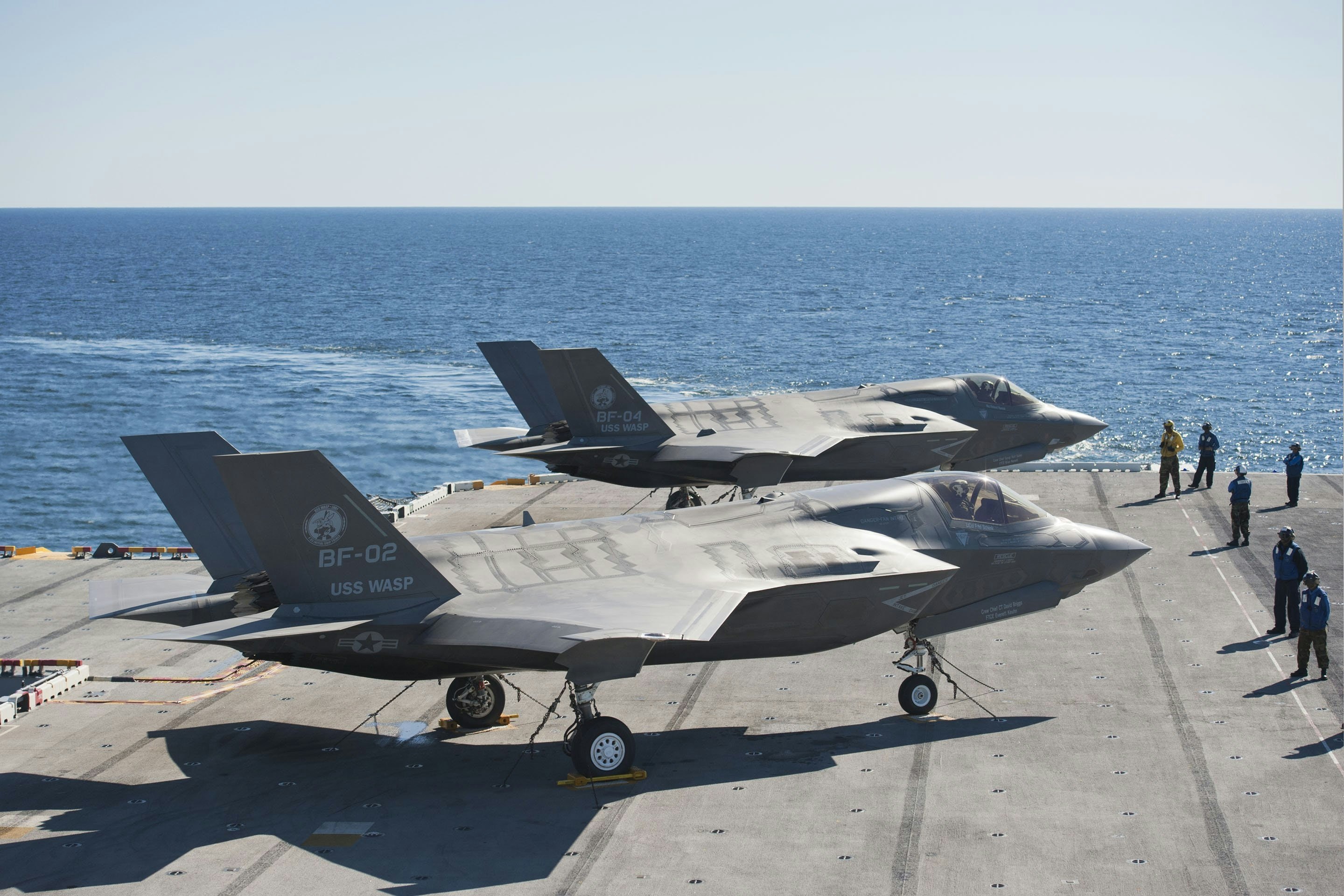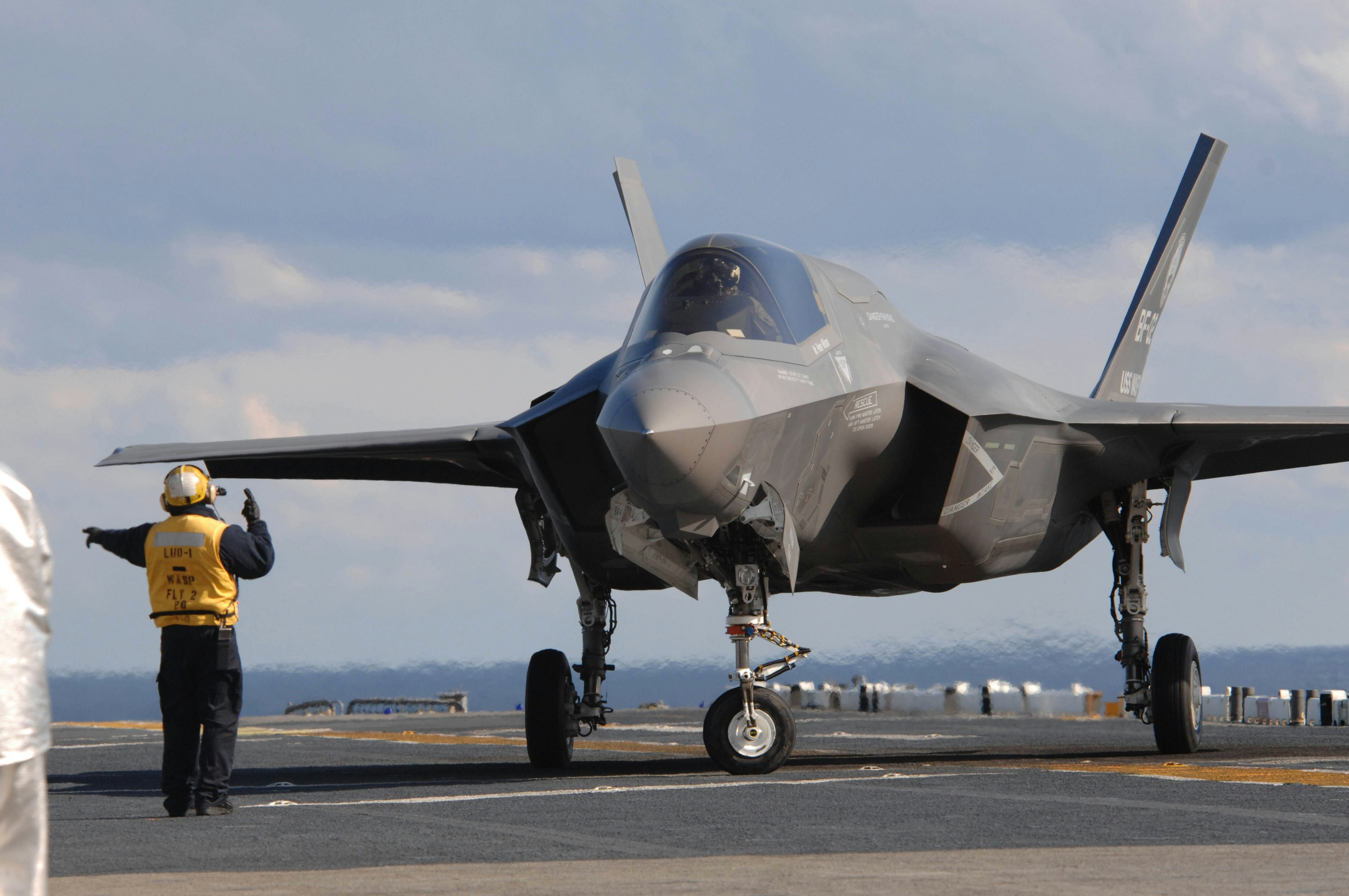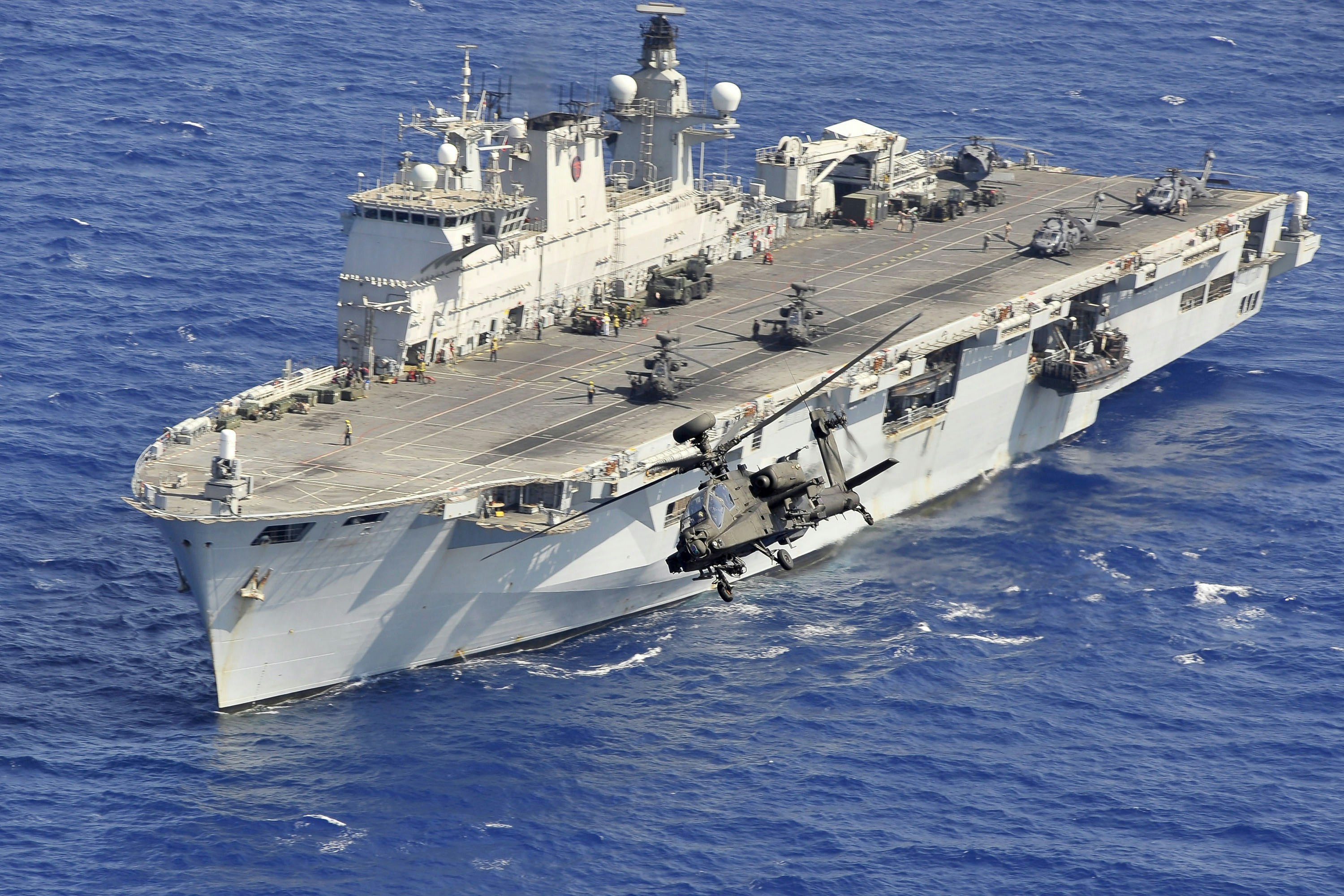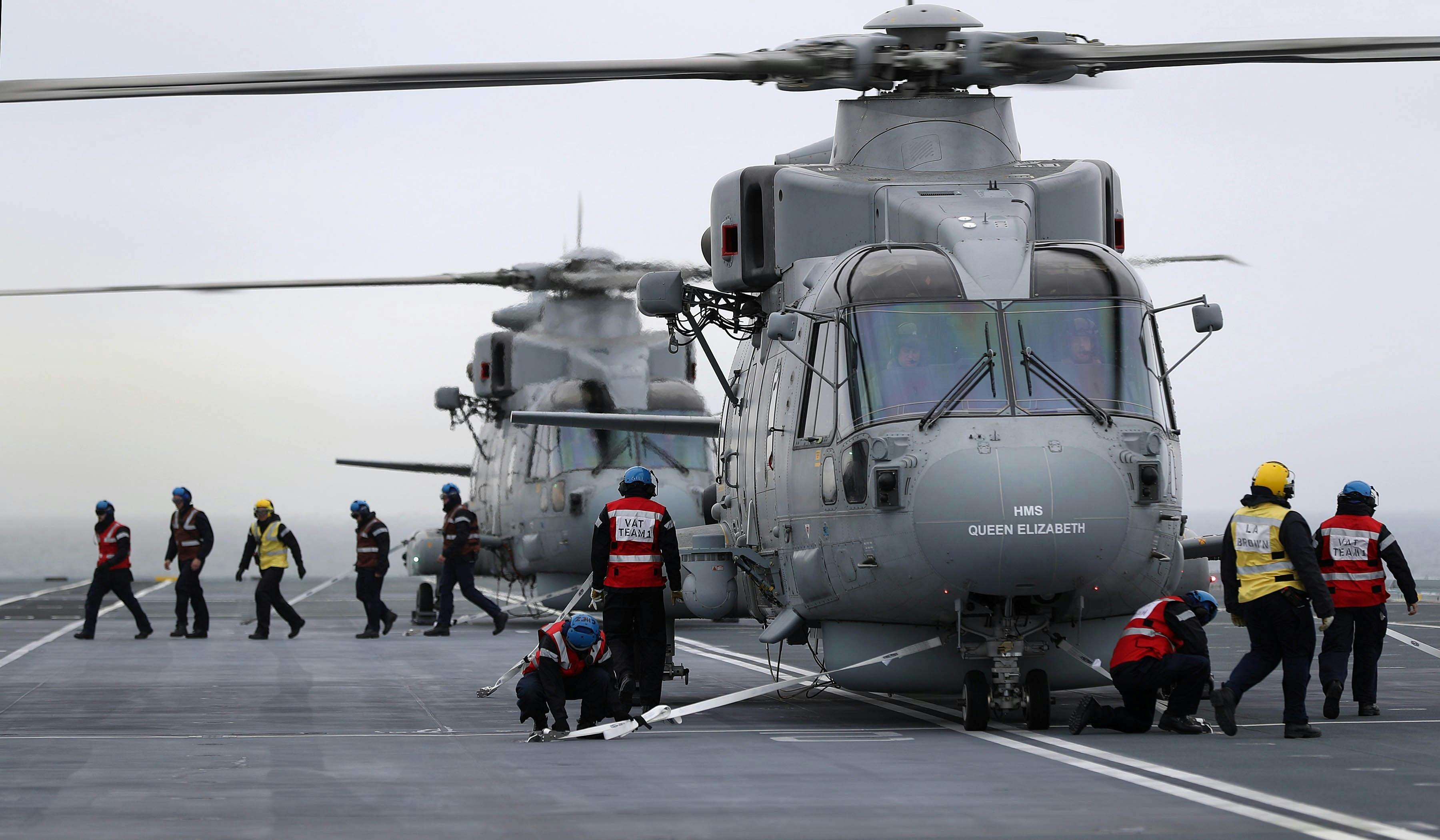A Merlin helicopter has been training with HMS Queen Elizabeth in Portsmouth Naval Base as part of her Rotary Wing Trials.
820 Naval Air Squadron has been putting Flight Deck crews through a series of drills and procedures that are part of flying trials. During the two days embarked the Merlin was used to verify many of the flight deck and hangar facilities by connecting up to the ship’s on-board electrical supply cables and refuelling hoses.
Dolphin currently rests in the central hangar. Today 820 NAS our permanent Squadron have been moving the helo around the ship testing both lifts, the fueling points on the flightdeck & electrical start points in the hangar. pic.twitter.com/cJtHjKWtzQ
— HMS Queen Elizabeth (@HMSQnlz) January 17, 2018
Lieutenant Commander Jim Cobbett said:
“The Merlins of 820 NAS are old friends of ours. The Squadron was the first rotary Unit to embark with us up in Scotland when we came out of build. These Sea Acceptance Trials (Air) or ‘SAT (Air)’ has proved the ship’s aircraft services are ready for action with a live helicopter and that everything functions correctly.”
HMS Queen Elizabeth will sail from her home port for rotary wing trial at sea in the coming weeks, where she will undergo deck trials with Royal Navy Merlin helicopters.
Lt Cdr Cobbett continued:
“Introducing the Ship to aviation and aviation to the Ship is all part of the learning structure we are going through. We are taking it slowly at first before we embark whole squadrons of rotary and fixed wing aircraft.”
A Merlin Mk2 from 820 Naval Air Squadron @RNASCuldrose landed onboard today assisting with trials whilst the ship is alongside our homeport HMNB Portsmouth pic.twitter.com/0xT2XB0yb0
— HMS Queen Elizabeth (@HMSQnlz) January 16, 2018
HMS Queen Elizabeth is expected to start fixed-wing flight trials with three or more F-35Bs off the eastern coast of the US around September this year. A fantastic info-graphic created by SaveTheRoyalNavy can be found here and details the timeline of the programme.
In order to prepare for operating from HMS Queen Elizabeth, Royal Navy sailors have also trained alongside their US Navy counterparts on the flight deck of the amphibious assault ship USS Wasp. Last year, the Royal Navy sent six Sailors to integrate into Wasp’s flight deck operations to prepare them for their upcoming Queen Elizabeth class aircraft carriers.

Royal Navy sailor Richard Clark said:
“Living with one another is good for integration, so when we work together, when we have your aircraft come to our flight decks, and vice versa, we’ll have a bit more awareness of how we each operate. It helps us work with you better on different platforms when we need to. This is the first group of guys who are not 1st Classes. Some of them have never been on a ship before, so for the younger guys, it’s good for them to get experience.”
Recent F-35 trials aboard the USS Wasp weren’t just an operational test for the United States Marine Corps, with much of the data produced being used to inform the USMC’s declaration of initial operating capability but also for the United Kingdom. UK personnel were fully embedded in the USS Wasp trials and will use the data gathered from this event, future trials and operational deployments to support the UK’s flying trials aboard HMS Queen Elizabeth off the US coast in Spring next year.

British F-35 pilots also recently embarked on the USS America for at-sea developmental testing phase 3 (known as DT), the last trial that paves the way for the US Marine Corps to deploy the jet operationally on amphibious assault ships. BAE Systems test pilot Pete Wilson said about the upcoming trials on the HMS Queen Elizabeth:
“This will not be a DT phase. Testing on the Queen Elizabeth will be like DTs 1, 2 and 3 combined. We don’t need to use fully instrumented aircraft; we already understand most of the loads on the aircraft systems, as we have tested that during earlier tests.”
HMS Prince of Wales will take over F-35 trials to allow HMS Queen Elizabeth to return to dock for her routine re-certification work.
Former Captain of the vessel Ian Groom told media that HMS Prince of Wales will need to be delivered during 2019 to allow flight trails to continue whilst Queen Elizabeth is undergoing inspection in dry dock. Quoted in Janes, Groom said:
“There is a further set of fixed-wing flying trials needed and HMS Prince of Wales has to carry them out. HMS Queen Elizabeth’s re-certification period in 2019 means we need HMS Prince of Wales then.”
What will the vessels carry when in operational service?
The term now used for the carriers embarked squadrons is ‘Carrier Air Wing’ (CVW). The vessels are capable of deploying a variety of aircraft in large numbers, up to a maximum in the upper fifties in surge conditions. Captain Jerry Kyd, commander of HMS Queen Elizabeth, commented on the initial deployment and the gradual increase in air wing numbers:
“We are constrained by the F-35 buy rate even though that was accelerated in SDSR in 2015, so initial operating capability numbers in 2020 are going to be very modest indeed. We will flesh it out with helicopters, and a lot depends on how many USMC F-35s come on our first deployment in 2021. But by 2023, we are committed to 24 UK jets onboard, and after that it’s too far away to say.”
In 2023, the UK will have 42 F-35 aircraft, with 24 being front-line fighters and the remaining 18 will be used for training (at least 5 on the OCU), be in reserve or in maintenance.

In addition to the joint force of Royal Air Force and Royal Navy F-35Bs and their pilots, the air wing is expected to be composed of a ‘Maritime Force Protection’ package of nine anti-submarine Merlin HM2 and four or five Merlin for airborne early warning; alternatively a ‘Littoral Manoeuvre’ package could include a mix of RAF Chinooks, Army Apaches, Merlin HC4 and Wildcat HM2.
The Crowsnest AEW&C aircraft will come from a number of the embarked Merlins (any of which can be fitted with the sensor package), the number again scaling with requirements.
We understand that vessel would still carry at least one F-35 squadron aboard in such circumstances to offer air defence as well as support to the helicopter assault activities.
A source we spoke to, currently flying the jet, explained to us that the vessels will deploy with the number and type of aircraft required for a specific deployments:
“Where F-35B is based is entirely down to the most suitable basing option for the tasks/missions is being sent to do. If that’s a well-founded host nation base, great; if it’s the Carrier, great; if it’s an austere location, fine. Range, logistics and other ‘enablers’ such as AAR and connectivity will determine what’s the best option.”
The Queen Elizabeth class mark a change from expressing carrier power in terms of number of aircraft carried, to the number of sortie’s that can be generated from the deck. The class are not the largest class of carrier in the world but they are most likely the smallest and least expensive carrier the Royal Navy could build which still have the advantages that large carriers offer.















Great to see sure and steady progress being made. Looking forward to seeing the Wildcats and HC4’s undergoing trials, not to mention the AAC Apaches and air force Chinooks, followed by the lightnings of course.Exciting times.
Yep!
It will be interesting to see how long QE will remain in dry dock????
Bait there ^^^
Don’t use a question mark (let alone 4) for a statement.
depends on how much gaffa tape is needed to block the holes
one thing that baffles me is that helo flight trials start now. however, early photos as displayed above show 5 or 6 merlins on the flight deck. surely to operate this number of merlins on the flight deck, some trials must already be completed and some degree of deck-competency in existence early. anyone care to explain?
Useful link here Julian https://ukdefencejournal.org.uk/culdrose-turns-carrier-exercise-kernow-turns-base-land-based-aircraft-carrier/
It all feels kinda slow, i wonder if it is being slowed down to allow for the f35’s.
It seems quite reasonable to me Steve, after all, these trials really shouldn’t be rushed, because that’s when accidents happen.
talk of 2023 before we have enough of our own f 35b shouldn’t be regarded as acceptable
trump should be told sort our planes or we’ll go elsewhere
Andy, the F35 is a joint US & UK aircraft project, and nothing to do with Trump. As the product matures the price per aircraft is falling. UK orders are staged so that we don’t buy more early models than needed and so get best value for money. Surprising as it may seem some folk in the MOD do know what they are doing.
not really. the fact that the carriers will launch with a handful of f35 and having to beg the US to help us not look stupid, doesn’t indicate the MOD know what they are doing. Yes prices will drop but either we need the capability or we don’t, if we need it then stop delaying and speed things up.
Steve – We do not look stupid. And especially in the eyes of the USMC. It is a factor of two things: The USMC needed all the F-35B production to get to IOC and overseas deployments objectives. We gave up that early space to take later lower cost production and, as it happened, to suit the delivery and commissioning dates of QE.
The USMC are not being ‘begged’ at all. They have recognised what we did and signed a written guarantee to provide a suitable number of aircraft and crew should we need extra operational, training or flight trials aircraft. They will be under UK command. It also suits their objectives of achieving full inter-operability with the UK carriers as we have achieved with the Wasp Class.
I never understand why people feel the need to denigrate everything the UK does …